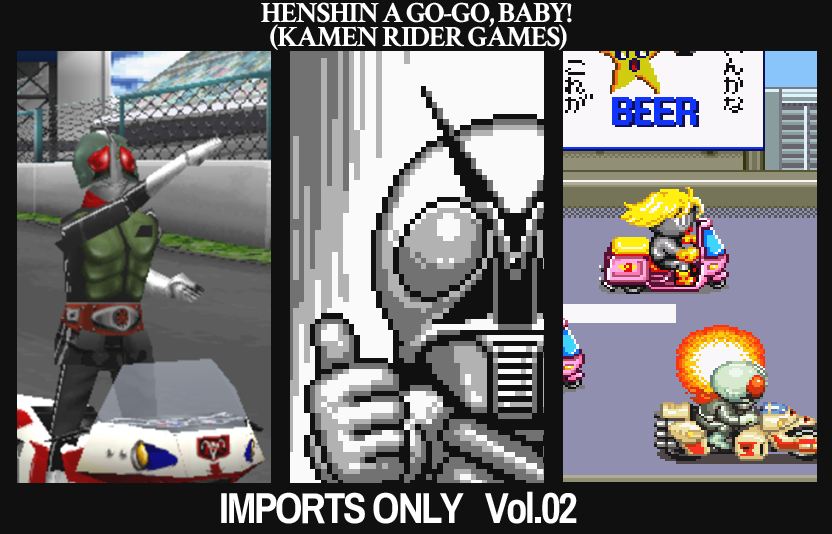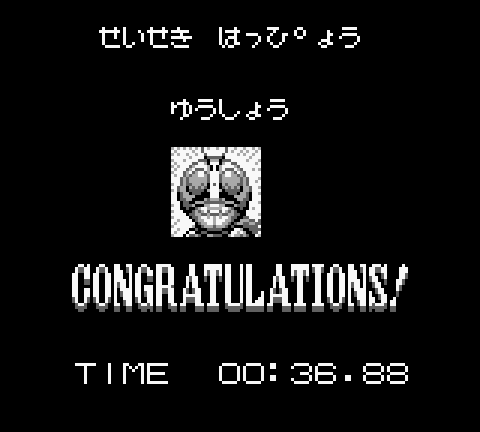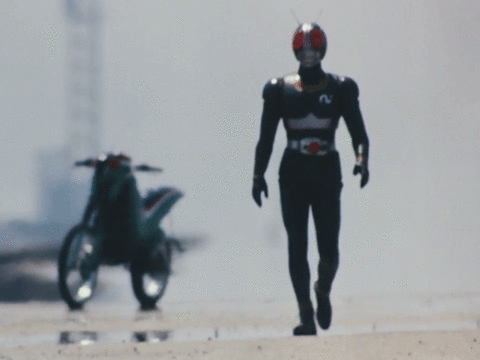Imports Only Vol. 2 - Henshin A Go-Go, Baby! (Kamen Rider Games)
By chaser324 3 Comments

Welcome to Imports Only - from anime to aspirators, it’s your encyclopedic cataloging and authoritative ranking of import racing games that never graced US shores.
Volume 2
Two entries into this series, and I’ve already realized that I made a significant omission in the rules and directives that I stated up front. One of the game’s selected for this entry forced me to question whether or not it truly was a racing game. Multiple websites that I consulted gave it that designation, but the internet is occasionally often wrong. So, I think it would serve us well to establish some sort of generic definition for what constitutes a “racing game” in the most basic sense.
For most people, the racing genre is going to immediately bring to mind games like Gran Turismo, Ridge Racer, and Forza that focus on traditional motorsport competition, but clearly it’s far more broad than that. It’s not defined by cars or any other particular vehicle, but more than that, I’d argue that it doesn’t have to be about transportation at all. I don’t think that we need to restrict ourselves just to games about moving from a starting point to an end point. So, with that in mind, here’s what I’m proposing as a working classification:
Racing Game - Any game where the primary objective is expeditious completion of a task prior to a timer expiring or prior to one or more opponents attempting the same task.
I think this is sufficiently inclusive enough that it will encapsulate all of the obvious cases while also allowing us to rule out any borderline cases such as games where a timer is incidental or games mistakenly assumed to be a racing game just because the screenshots all showed people in cars. It still leaves room for debate since it’s not an exhaustive and detailed definition, but all I actually need it to do is provide context for thinking about how to categorize a game.
Let it be stated though, for the record, that I will serve as the final arbiter of what is and what is not a racing game for the purposes of this series. I’m willing to hear arguments if you’ve got them, but by the time you see a game here, the decision has been made and is probably final.
With all of that in mind, there’s one game in today’s set that I’ve decided to disqualify from receiving a rank, but I’m still going to talk about it since I think it’s a cool game worth checking out. I’ll say more about why I don’t think it counts as a racing game when we get to it.
Today’s Theme: Kamen Rider
For a lot of us in the US, awareness of Japanese tokusatsu (live-action sci-fi/fantasy with special effects) begins (and for maybe also ends) with Godzilla and Power Rangers. The former is what began to popularize the format in the 1950s, but in the 1970s, the format started to drift towards a focus on henshin (“transforming”) heroes. This movement was kicked off by Kamen Rider in 1971 but several similar shows followed such as Super Sentai, the series that Saban uses as source material for Power Rangers.
While the details differ with every iteration, each hero to take up the Kamen Rider mantle is typically bestowed with their power by way of some sudden tragic event, and then they reluctantly use those powers to fight some evil organization bent on world domination. In a twist of fate, it’s often these bumbling evil organizations themselves that are responsible for giving the Kamen Rider their powers, through cybernetic enhancements, magic, or some other means, but the hero escapes before they can be brainwashed into becoming an agent of evil.
Every Kamen Rider also has a unique custom motorcycle they refer to as a “Rider Machine”. During the 70s and 80s, these were primarily produced for the show by Suzuki, but in the following years many manufacturers have been called upon including Honda, Harley-Davidson, Yamaha, and Ducati.

Kamen Rider is currently in its 26th iteration, typically rebooting itself annually. The show was not on TV throughout the 90s, but even then, there were things like movies and manga that maintained interest in the property. In fact, two of the games looked at in this post are based on Kamen Rider SD (“super-deformed”), an animated short and manga that brings together several previous Kamen Riders to defend the planet.
As cool as certain aspects of Kamen Rider look, I really dig the style of Kamen Rider Black in particular, it’s been a show targeted primarily at kids throughout its entire run, so it would probably be hard for any adults to get into except maybe by way of nostalgia for things like Power Rangers/Super Sentai (which similarly is also still in production and very popular).
As far as Kamen Rider video games go, while some of them do focus on the actual motorcycle riding like those I’m about to discuss, the majority of them are actually fighting games and brawlers that have the Kamen Riders fighting on foot.

In case you thought we were done with Simple series games after last week, here’s another one with even more still on deck for the future. In fact, Kamen Rider: The Bike Race is largely just a reskin of an earlier Simple 1500 game called simply The Bike Race.
This is a licensed budget title, and like the Combat Mecha Xabungle game we looked at previously, it’s stripped down and bare-bones. The biggest selling point for fans of Kamen Rider is easily the inclusion of a full roster of every iteration of the hero up to this game’s release on PlayStation in 2001. They don’t look particularly great and don’t seem to have any stat differences, but they are all in there.
The racing itself is typical circuit racing with a few minor wrinkles. There are boost items to collect on the track, but they’re not incredibly useful since you can also boost almost constantly on straight sections by spamming down on the d-pad to do wheelies. While each race is head-to-head against one other Kamen Rider, the fodder henchmen from the show appear as random riders on the track and will try to kick you if you get too close. You can kick back at them to knock them down, but I found it better to just try to avoid them since I could rarely manage to knock them down without sustaining damage. Whenever you get banged up enough from kicks or running into the walls to fill your damage meter, you’ll spin out and fall off the bike for a bit while the meter resets.
The racing takes place on three fairly simple tracks, the first two of which are easy enough to get through with the simple and responsive bike handling, but the third can really only be completed by pinballing your way through the corners that are far too tight for the Kamen Riders’ cornering capabilities. Unless you slow down down to a complete stop, it’s just not possible to smoothly get through a corner on this final track. Luckily, the AI will probably have an even harder time handling it than you will, so you can still easily win.
Aside from standard grand prix, time trial, and splitscreen multiplayer, there is another mode that challenges you to knock down as many of the henchmen riders as you can before a timer expires, but it seems completely broken to me. The time bonuses from completing a lap and knocking down henchmen were enough that I was able to keep going seemingly forever. I stopped after 30 laps because there didn’t seem to be an end in sight.
The menus are all in Japanese, but they don’t go that deep and are easy enough to find your way through without being able to read any of it.

Kamen Rider SD: Hashire! Mighty Riders for the Game Boy, like the SNES game discussed below, are both based on the Kamen Rider SD manga and animated short and feature their chibi super-deformed art style and a collection of the Kamen Riders from before this game’s release in 1993. While the art style doesn’t come through all that well in the actual top-down racer gameplay, the art of each Kamen Rider you get for completing a level felt like an actual reward to me, which is good since playing the game isn’t all that rewarding.
The game has two main modes, the first of which has you selecting one of three groups of Kamen Riders consisting of three riders apiece, and then one by one guiding each rider through their own unique level that plays a bit like a bad version of Spy Hunter or Road Fighter.
The main goal in each level is to reach the top of the screen as quickly as possible without getting blown up by depleting your fuel gauge, which will only occur by taking damage through hitting walls or exploding barrels. Enemy riders and obstacles won’t do direct damage but can cause you to spin out into walls effectively still hurting you. The enemies aren’t all that much of a problem since your kick attack can deal with them pretty easily, but the obstacles can be a pretty big pain to get past. A lot of the obstacles in this game require you to do either hit a jump, use a boost pad, or collect a powerup such as a shield in order to progress without damage. Unfortunately, it’s very easy to miss these since your top-down view is extremely zoomed in, not allowing you much time to prepare for things appearing ahead of you. This can turn a few of the levels into a bit of a trial and error affair with you needing to fail once or twice just to get a feel for the level, and even then you might still accidentally mess up and end up just barely scraping past the finish line.
In spite of my complaints about the narrow view, I was still able to quickly complete all three sets of level and see all of the art. Now that I have screenshots of all of them, I don’t see much reason to ever play through the main mode of this again. With so much focus on just surviving each level, I doubt many people will be interested in reducing their times.

The other primary mode is a grand prix where you select one rider and then race against a field of five other racers, comprised of a random assortment of enemy henchman and other Kamen Riders along with one nigh unbeatable and seemingly invincible boss character. This mode takes you through all nine of the courses you see in the other mode, and in order to progress from one race to the next you must achieve the nearly impossible task of somehow coming in first place ahead of the boss character. Seriously, you do not even try this without the aid of emulator enabled cheats or something similar because coming in first place nine times in a row against these evil GranShocker bastards will take nothing short of a literal miracle bestowed upon you by the highest order of archangel. If you do manage to achieve this feat, you get a screen that says congratulations, followed by a screen with your selected Kamen Rider and some text that I can’t read but I’m just going to assume is the secret to immortality, which will unfortunately seem like a cruel joke as you read it from your death bed after spending your entire life staring at a Game Boy.
As far as language barrier issues go, there is a lot of flavor text from the Riders and silly bits from Tōbei Tachibana, the mentor and racing coach that directs the SD squad of Kamen Riders. Aside from that however, there’s no significant barrier to playing the game.

Now finally we arrive at the game that drove me to need for a working definition of “racing game”. A lot of websites list Kamen Rider SD: Shutsugeki!! Rider Machine for the SNES as a racing game, and I can see why you might think that if you just looked at a few screenshots. There are motorcycles. There’s a speedometer. There’s a time limit. These are telltale signs of a racing game, but as soon as you try playing the game, you immediately realize that those people got it wrong. This is very much a beat ‘em up in the tradition of games like Streets of Rage or Final Fight (for the record, @mento got it right when he added data for this game to the GB wiki).
So, with it established that this is a beat ‘em up, I just wanted to point out that it’s a good one of those. The main thing that drew me into it was the cute super-deformed art style - I have to admit that I can be a bit of a sucker for it. Looks aside, I found it fun to play too, although maybe a bit overly simplistic and repetitive, especially since this game takes nearly two hours to play through and has to be done in one sitting since it lacks any saves or passwords.

Like the two previously discussed games, you’re able to kick from your bike, but this time it’s the focus of the game since it’s required to defeat all of the enemies on every screen to proceed. You can accelerate and decelerate your bike to help shift the enemies left or right on the screen, but you’re always barreling forward aside from some brief mid-level pit stops where you get to select a limited use special weapon - the majority being some sort of projectile that either spins around you or is projected in front of you. The sub weapons are particularly helpful when dispatching the end level bosses, several of which can be a bit frustrating with the sort of cheap difficult to avoid attacks you’ve come to expect from beat ‘em up bosses over the years.
There’s also a throwaway two-player versus mode where you kick at each other and try to empty each other’s health bars. Nothing else to say about it...it barely deserves a mention.
Not knowing Japanese, you are going to miss out on whatever plot development is happening in the radio messages you receive between levels, but the game is completely playable start to finish without issue.
Where Do They Rank?

As alluded to at the top of this post, I’ve decided to disqualify Kamen Rider SD: Shutsugeki!! Rider Machine from consideration since it’s not a racing game. Very unfortunate since it was absolutely the game I liked the most out of this bunch, and purely in terms of my personal enjoyment, I’d say it trumps Edit Racing, currently the best import racer of all time.
Looking to the other two games in consideration here, in relation to each other, I’m going to reluctantly give the nod to Kamen Rider: The Bike Race since it’s far less frustrating to actually play through. However, it’s a very slight edge because I really do like that Kamen Rider SD art style.
Placing them into the overall rankings, I’m going to squeeze them both in between The Tousou Highway, which I’m still giving substantial credit to for a solid concept in spite of the mistakes in the execution, and Sentou Mecha Xabungle, a game which I expect see anchoring the bottom of this list for quite a while to come.
So, as of today, Kamen Rider: The Bike Race is the third best import racer of all time and Kamen Rider SD: Hashire! Mighty Riders is fourth, and remember that you can keep track of the official standings at any time by checking the official spreadsheet.
So Long For Now

That’s going to do it for this entry. This post is about 500 words shorter than last time, but I think I could still do with cutting it down even more. I feel like I might be getting a bit more reaccustomed to blog writing, but it may take a while yet for it to get to where I want it. Luckily we still have a long way to go, so I’m going to have plenty of time to improve before we’re done.
3 Comments